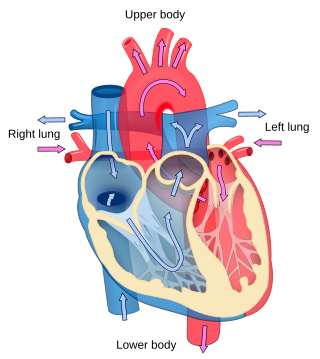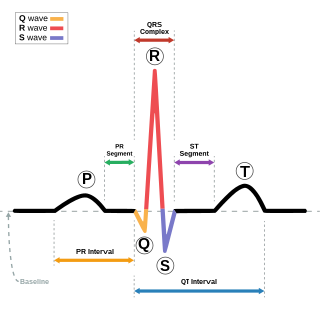Related Research Articles

An arteriovenous malformation (AVM) is an abnormal connection between arteries and veins, bypassing the capillary system. Usually congenital, this vascular anomaly is widely known because of its occurrence in the central nervous system, but can appear anywhere in the body. The symptoms of AVMs can range from none at all to intense pain or bleeding, and they can lead to other serious medical problems.

Cardiology is the study of the heart. Cardiology is a branch of medicine that deals with disorders of the heart and the cardiovascular system. The field includes medical diagnosis and treatment of congenital heart defects, coronary artery disease, heart failure, valvular heart disease, and electrophysiology. Physicians who specialize in this field of medicine are called cardiologists, a sub-specialty of internal medicine. Pediatric cardiologists are pediatricians who specialize in cardiology. Physicians who specialize in cardiac surgery are called cardiothoracic surgeons or cardiac surgeons, a specialty of general surgery.

Cardiac arrest, also known as sudden cardiac arrest, is when the heart suddenly and unexpectedly stops beating. As a result, blood cannot properly circulate around the body and there is diminished blood flow to the brain and other organs. When the brain does not receive enough blood, this can cause a person to lose consciousness. Coma and persistent vegetative state may result from cardiac arrest. Cardiac arrest is also identified by a lack of central pulses and abnormal or absent breathing.

Electrocardiography is the process of producing an electrocardiogram, a recording of the heart's electrical activity through repeated cardiac cycles. It is an electrogram of the heart which is a graph of voltage versus time of the electrical activity of the heart using electrodes placed on the skin. These electrodes detect the small electrical changes that are a consequence of cardiac muscle depolarization followed by repolarization during each cardiac cycle (heartbeat). Changes in the normal ECG pattern occur in numerous cardiac abnormalities, including:
Dying is the final stage of life which will eventually lead to death. Diagnosing dying is a complex process of clinical decision-making, and most practice checklists facilitating this diagnosis are based on cancer diagnoses.

Peter Safar was an Austrian anesthesiologist of Czech descent. He is credited with pioneering cardiopulmonary resuscitation (CPR).

Oxygen therapy, also referred to as supplemental oxygen, is the use of oxygen as medical treatment. Supplemental oxygen can also refer to the use of oxygen enriched air at altitude. Acute indications for therapy include hypoxemia, carbon monoxide toxicity and cluster headache. It may also be prophylactically given to maintain blood oxygen levels during the induction of anesthesia. Oxygen therapy is often useful in chronic hypoxemia caused by conditions such as severe COPD or cystic fibrosis. Oxygen can be delivered via nasal cannula, face mask, or endotracheal intubation at normal atmospheric pressure, or in a hyperbaric chamber. It can also be given through bypassing the airway, such as in ECMO therapy.

Second-degree atrioventricular block is a disease of the electrical conduction system of the heart. It is a conduction block between the atria and ventricles. The presence of second-degree AV block is diagnosed when one or more of the atrial impulses fail to conduct to the ventricles due to impaired conduction. It is classified as a block of the AV node, falling between first-degree and third degree blocks.

High-altitude pulmonary edema (HAPE) is a life-threatening form of non-cardiogenic pulmonary edema that occurs in otherwise healthy people at altitudes typically above 2,500 meters (8,200 ft). However, cases have also been reported between 1,500–2,500 metres or 4,900–8,200 feet in more vulnerable subjects.
A flatline is an electrical time sequence measurement that shows no activity and therefore, when represented, shows a flat line instead of a moving one. It almost always refers to either a flatlined electrocardiogram, where the heart shows no electrical activity (asystole), or to a flat electroencephalogram, in which the brain shows no electrical activity. Both of these specific cases are involved in various definitions of death.

Atrioventricular block is a type of heart block that occurs when the electrical signal traveling from the atria, or the upper chambers of the heart, to ventricles, or the lower chambers of the heart, is impaired. Normally, the sinoatrial node produces an electrical signal to control the heart rate. The signal travels from the SA node to the ventricles through the atrioventricular node. In an AV block, this electrical signal is either delayed or completely blocked. When the signal is completely blocked, the ventricles produce their own electrical signal to control the heart rate. The heart rate produced by the ventricles is much slower than that produced by the SA node.
St. Jude Medical, Inc. was an American global medical device company headquartered in Little Canada, Minnesota, U.S., a suburb of Saint Paul. The company had more than 20 principal operations and manufacturing facilities worldwide with products sold in more than 100 countries. Its major markets include the United States, Europe, Latin America and Asia-Pacific. The company was named after Jude the Apostle, the patron saint of lost causes.

Bernard Lown was a Lithuanian-American cardiologist and inventor. Lown was the original developer of the direct current defibrillator for cardiac resuscitation, and the cardioverter for correcting rapid disordered heart rhythms. He introduced a new use for the drug lidocaine to control heartbeat disturbances.
Oliver Cope, was an American surgeon known for his work in parathyroid surgery, burns treatment and breast cancer treatment. He is also remembered for describing the Churchill-Cope reflex.
Rapid Interpretation of EKG's is a best-selling textbook for over 30 years that teaches the basics of interpreting electrocardiograms. It adopts a simplistic fill-in-the-blank style and is suited for medical students and junior residents. The book was written by Dale Dubin, M.D., a plastic surgeon and convicted felon, who has written several books on cardiology including Ion Adventure in the Heartland: Exploring the Heart's Ionic-Molecular Microcosm and Understanding Cardio-pulmonary Resuscitation.
Anh Tuan Dinh-Xuan is a French researcher, doctor and university professor. He manages the hospital department of Physiology - Practical examinations at Cochin hospital in Paris. His research concerns the physiology of the respiratory system and the physiopathology of pulmonary diseases.

Franz Loogen was a German cardiologist. He is a pioneer of cardiac catheterization and is considered the founding father of cardiology as an independent specialty of internal medicine in Germany. He held the first cardiology chair outside paediatrics in Germany and founded the so-called "Düsseldorf School of Cardiology", from which many full professors, chief physicians and practising cardiologists have emerged. He also looked after the Germany national football team at the 1954 World Cup as team doctor.

Peter John Firth Baskett (1934–2008) was a Northern Irish physician, specializing in anaesthesia. He was responsible for the introduction of paramedics into the United Kingdom, created specialist ambulances for delivering on-scene pain relief to patients, and was the first chairman of the European Resuscitation Council.

Ardem Patapoutian is a Lebanese-American molecular biologist, neuroscientist, and Nobel Prize laureate of Armenian descent. He is known for his work in characterizing the PIEZO1, PIEZO2, and TRPM8 receptors that detect pressure, menthol, and temperature. Patapoutian is a neuroscience professor and Howard Hughes Medical Institute investigator at Scripps Research in La Jolla, California. In 2021, he won the Nobel Prize in Physiology or Medicine jointly with David Julius.
Thomas F. Lüscher is a Swiss professor of cardiology, director of research, education and development and a consultant cardiologist at the Royal Brompton and Harefield NHS Foundation Trust and Imperial College London, and director of the Center for Molecular Cardiology at the University of Zurich.
References
- 1 2 3 Fine print redux: beneficent doctor made child pornos, Yale Daily News, 7 December 2001
- ↑ Sullivan, Patrick (2001). "Book Review: Rapid Interpretation of EKG's, 6th edition". Canadian Journal of Anesthesia. 48: 1050. doi: 10.1007/bf03016605 .
- ↑ Dubin, Dale (2000). Rapid Interpretation of EKG's (6th ed.). Tampa, FL: Cover Publishing. ISBN 0-912912-06-5.
- ↑ Dubin, Dale (2003). Ion Adventure in the Heartland: Exploring the Heart's Ionic-Molecular Microcosm. Cover Publishing Company. ISBN 978-0-912912-11-0.
- ↑ Dubin, Dale (1972). Understanding Cardio-pulmonary Resuscitation. C.P.R. Inc.
- ↑ Nossiter, Adam (1986). "Doctor's arrest upsets his nudist neighbors". St. Petersburg Times.
- ↑ "Deep Trouble Undercut Doctor's Fine Success". Orlando Sentinel. 1 September 1986.
- 1 2 "Dale Dubin Sentenced To Five Years". United Press International. 7 March 1987.
- ↑ "After prison, a floral group". Tampa Bay Times. Retrieved 2024-08-26.
- ↑ PP11976,Dubin, Dale,"Hibiscus plant named `Hoosiers`",issued 2001-07-03
- ↑ Duta, Daniela. "Dale Dubin". Scribd.